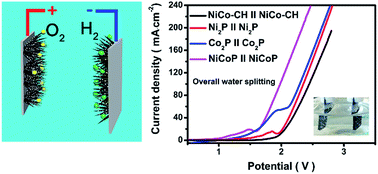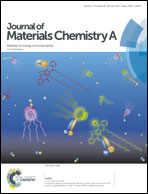Hierarchical NiCoP nanocone arrays supported on Ni foam as an efficient and stable bifunctional electrocatalyst for overall water splitting†
Abstract
Design of cost-effective, highly efficient and stable bifunctional electrocatalysts for overall water splitting is necessary for renewable energy systems. In this study, NiCoP nanowire arrays grown on 3D Ni foam (NiCoP NWAs/NF) were successfully synthesized by a two-step method, which were developed as novel bifunctional electrocatalysts for evaluating in the hydrogen evolution reaction (HER) and oxygen evolution reaction (OER). Their special cone nanostructure and bifunctional crystal structure enable the electrocatalysts to display remarkable electrocatalytic performance and stability for OER and HER (maintained for 28 h in the long-term HER and OER stability test with slight attenuation). The electrodes have very low overpotentials of 197 mV and 370 mV for HER and OER in 1.0 M KOH at a high current density of 100 mA cm−2, respectively. All the merits can be attributed to several parameters: the inherent nature of transition metal phosphides, the presence of a bimetal synergetic effect, special morphology design, and the formation of “secondary” electrocatalysts on the surface of NiCoP. Meanwhile, the excellent bifunctional electrocatalysts can be developed as both anode and cathode of an alkaline electrolyzer (1.0 M KOH) which needs a cell voltage of 1.64 V to achieve 20 mA cm−2 current density.



 Please wait while we load your content...
Please wait while we load your content...